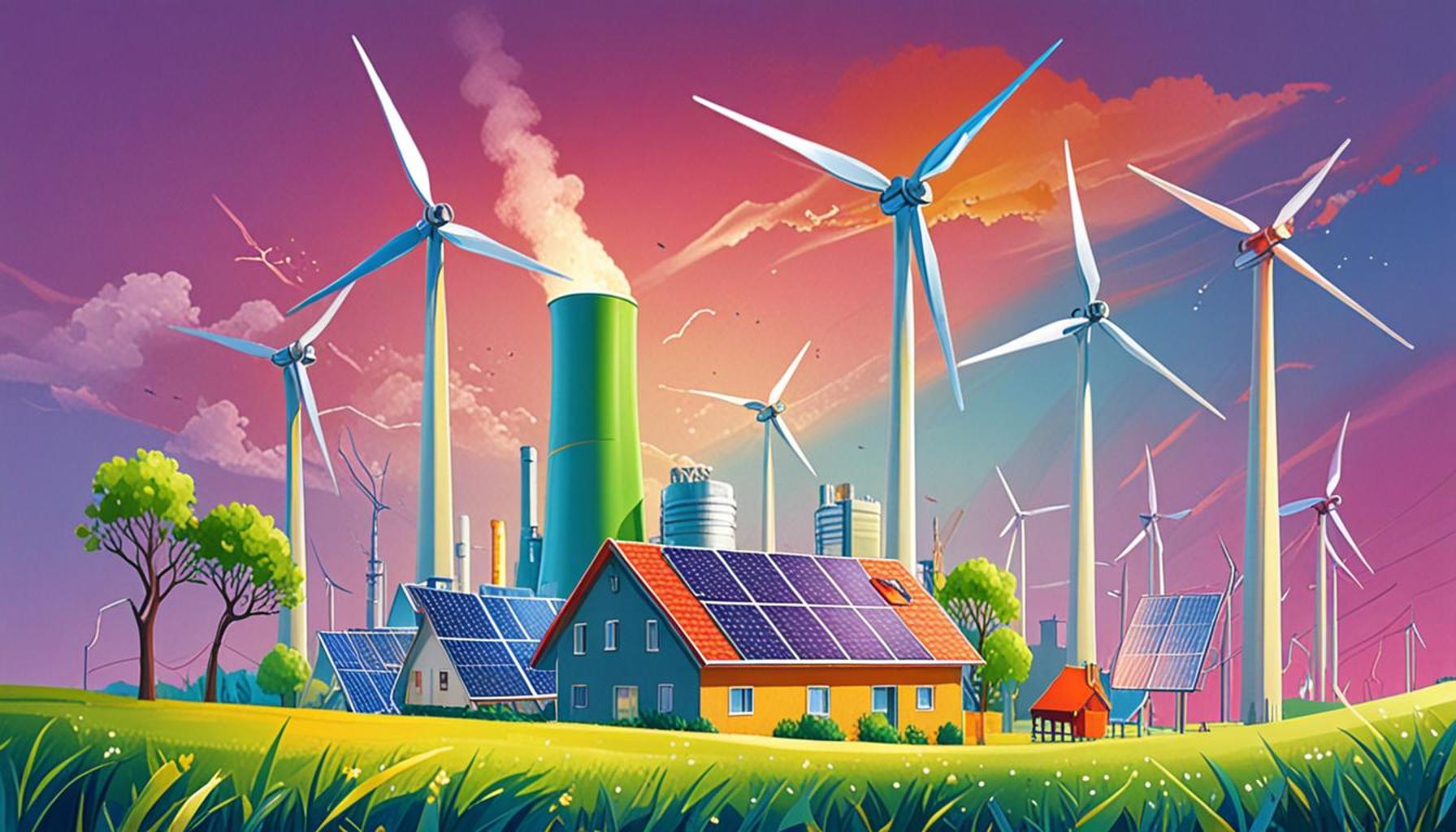The Impact of Government Subsidies on the Renewable Energy Industry

Transformative Forces in Renewable Energy
The renewable energy sector is experiencing an unprecedented transformation, driven in large part by government subsidies. These financial incentives play a pivotal role in shaping the industry by promoting sustainable practices and reducing reliance on fossil fuels. As countries around the globe increasingly acknowledge the imperative to combat climate change, understanding the impact of these subsidies becomes essential.
In the United States, various forms of subsidies have significantly influenced the adoption and growth of renewable technologies. Key examples include:
- Tax credits for solar and wind energy projects, such as the Investment Tax Credit (ITC) and the Production Tax Credit (PTC), which have proven instrumental in making these technologies more economically viable. The ITC allows homeowners and businesses to deduct a significant percentage of installation costs from their federal taxes, while the PTC offers per-kilowatt-hour credits for energy produced by qualifying renewable sources.
- Grants to support research and development, like those provided by the U.S. Department of Energy (DOE), which invests billions into innovative energy solutions, fostering advancements in solar efficiency and battery storage technologies. For instance, grants have led to breakthroughs in concentrating solar power (CSP) systems that could deliver energy even during cloudy days or at night.
- Loan programs that facilitate affordable financing for green initiatives, such as the DOE’s Loan Programs Office, which has backed the development of large-scale solar farms and wind projects. This access to capital is vital for new enterprises and helps established companies expand their renewable portfolios.
As a result, the renewable energy industry has witnessed remarkable growth. Recent reports indicate that renewable sources contributed approximately 29% to the nation’s energy mix in 2021, a number that continues to climb as states set ambitious targets for reduction in greenhouse gas emissions. Additionally, the increasing adoption of electric vehicles (EVs) is pushing demand for clean electricity even higher. This shift towards cleaner energy sources serves as a testament to the potential for innovation when financial support is available.
However, the effectiveness of these subsidies is often debated among policymakers, environmentalists, and industry insiders. Supporters argue that they are essential for fostering innovation, enabling new players to enter the market and helping to level the playing field against established fossil fuel industries. Critics, on the other hand, highlight potential inefficiencies and market distortions that arise from such incentives, arguing that they can sometimes lead to overproduction or misallocation of resources. This ongoing dialogue invites further exploration into the complexities of government intervention in the energy market and raises questions about the sustainability of these subsidies in the future.
In navigating this intricate landscape, one thing is clear: the future of energy policies will be shaped not only by technological advancements but also by the frameworks and financial structures that support them. As society continues its quest for a sustainable energy future, the role of government subsidies will remain a key point of interest worthy of further examination.
RECOMMENDED: Check out this similar article
Government Subsidies: Catalyst or Crutch?
The conversation surrounding government subsidies in the renewable energy sector is complex and multifaceted. These financial incentives, designed to stimulate the growth of clean energy technologies, have undeniably led to substantial advancements in the field. However, the question remains: are these subsidies truly a catalyst for long-term sustainability, or do they merely serve as a temporary crutch, propping up an industry that is not yet self-sufficient?
In examining the impact of subsidization on specific renewable energy sources, it becomes evident that the benefits can be both immediate and far-reaching. For instance, wind energy, which has rapidly expanded in recent years, owes much of its success to the combined influence of the Production Tax Credit (PTC) and state-level renewable energy mandates. These policies have not only made large-scale wind projects financially feasible, but they have also encouraged substantial private investments—resulting in a sector that now employs over 100,000 people in the U.S. alone.
- Solar Energy – The installation of solar panels has surged, with residential systems often reduced to costs that make them competitive with traditional energy sources. As of 2021, the solar industry employed more than 250,000 workers, reflecting the direct impact of initiatives like the Investment Tax Credit (ITC).
- Battery Storage – The development of energy storage technologies, crucial for stabilizing renewable energy supply, has received significant funding via DOE grants. Innovations in battery technologies have paved the way for more effective integration of renewables into the grid.
- Geothermal and Bioenergy – Often overlooked, these sectors have also benefited from targeted subsidies, enabling new startups and technologies to emerge and compete in the market, further diversifying the renewable energy landscape.
Despite these successes, challenges persist. Critics question the long-term viability of systems overly reliant on subsidies, noting that when financial support begins to diminish, many projects may falter. This has been illustrated in markets where sudden reductions in subsidies led to dramatic drops in renewable installations and, consequently, job losses. For example, following the expiration of certain tax incentives, solar installations plummeted sharply, demonstrating the potential volatility attached to subsidy-dependent growth.
Moreover, some industry experts argue that while subsidies stimulate initial growth, they can also create a false sense of security for companies, stifling innovation. In environments heavily influenced by government support, there may be less urgency to develop competitive technologies or to optimize existing systems. The balance between fostering an emerging market and encouraging independent growth is delicate, and it raises pressing questions about the future direction of energy policy in the United States.
Continued evaluation of these subsidy programs is paramount as stakeholders—from government policymakers to environmental groups and industry leaders—seek to navigate the ever-evolving energy landscape. As conversations advance, it is essential to determine not only how to allocate funds effectively but also how to cultivate a lasting foundation for the renewable energy industry that can thrive without sustained government intervention.
| Advantage | Impact |
|---|---|
| Increased Investment in Renewable Energy | Government subsidies attract private investments, leading to growth in solar, wind, and other renewable sectors. |
| Job Creation | The renewable energy industry generates new employment opportunities across various skill levels, reducing unemployment in local regions. |
The impact of government subsidies on the renewable energy industry is profound, driving advancements and facilitating the transition towards a cleaner future. Government-backed fiscal policies not only enhance the viability of renewable projects but also ensure that they become competitive against traditional fossil fuels.One specific area of focus is the technological innovation enabled by these subsidies. By providing financial support for research and development, the government encourages companies to innovate, leading to improved efficiencies in energy extraction and application. This innovation often translates into lower costs for consumers and businesses alike.Moreover, subsidies can foster a more sustainable energy market by promoting energy independence. When governments invest in local renewable projects, it diminishes reliance on foreign oil, which is aligned with national security objectives. This shifts the focus to energy strategies that prioritize local resources and create resilience within the economy. These facets of government subsidies highlight their essential role in the renewable energy landscape, meriting consideration for those interested in the future trajectory of energy production and consumption.
LEARN MORE: This related article may interest you
The Broader Economic Implications of Subsidies
While the direct impact of government subsidies on the renewable energy industry is undoubtedly significant, the ripple effects on the broader economy also warrant careful consideration. As funding and incentives fuel growth in sectors like solar and wind energy, they catalyze a transition that generates opportunities in related domains. This multidimensional influence extends beyond the realm of electricity production and encompasses job creation, technological advancement, and energy security.
First and foremost, the emergence of a vibrant renewable energy sector has the potential to create a wealth of employment opportunities throughout various levels of the economy. According to the U.S. Bureau of Labor Statistics, positions related to renewable energies, particularly in solar and wind, are projected to grow significantly, with estimates indicating the creation of hundreds of thousands of new jobs over the next decade. These roles often yield paychecks that surpass the national average, providing livelihoods not only for installers and technicians but also for engineers, manufacturers, and support staff engaged in research and development efforts.
Furthermore, the infusion of subsidies into renewable energy projects fosters innovation and encourages technological advancements. For example, government support through grants and funding has propelled cutting-edge research in advanced photovoltaic materials and turbine designs. This investment drives competition within the industry, leading to breakthroughs that improve efficiency and lower production costs, ultimately benefiting consumers. A thriving research ecosystem fosters collaboration between public institutions and private companies, strengthening the nation’s technological grip on renewable resources.
However, as the renewable energy industry gains traction, it also raises essential questions about market dynamics and competition. As more companies enter the fray, reliant on subsidies for survival, the risk of market saturation increases. A strong reliance on government support may inadvertently hinder the organic growth of a sustainable market, making it susceptible to fluctuations that arise from political shifts or budgetary constraints. When these subsidies are reduced or eliminated, companies may struggle to adapt, as evidenced by the sporadic growth patterns in states that have experienced changes to renewable energy tax credits.
- Market Volatility – The rollercoaster ride of subsidies can lead to market volatility, impacting the investment landscape. Investors may find it challenging to allocate funds to projects if they anticipate potential subsidy reductions, leading to an unpredictable market environment.
- Localized Economic Benefits – State-level subsidies have also created localized economic cohesion. Places such as California and Texas have emerged as renewable energy powerhouses, benefiting from significant investments in jobs and infrastructure, providing a template for other states eager to replicate this success.
Beyond economic growth, the adoption of renewable energy promotes energy independence and enhances national security. By reducing reliance on foreign oil and fossil fuel imports, the United States strengthens its energy sovereignty and diminishes vulnerability to international market fluctuations. With government subsidies supporting the transition to renewables, the country can bolster its commitment to reducing greenhouse gas emissions and meet international climate agreements.
Ultimately, while subsidies act as a crucial bridge to offset initial costs and risks in the renewable energy sector, their long-term effectiveness must be continuously evaluated. Understanding their impact on economic stability, market competition, and energy independence will be essential in shaping future policies that promote a resilient and independent renewable energy landscape.
CHECK OUT: Click here to explore more
Conclusion: Navigating the Future of Renewable Energy Subsidies
The role of government subsidies in the renewable energy industry is a double-edged sword, serving as both a catalyst for growth and a potential risk factor for market stability. As we have explored, these subsidies significantly accelerate the shift toward cleaner energy sources, driving job creation, technological advancements, and enhanced energy security. They provide a crucial financial cushion that enables fledgling industries to flourish in an era where fossil fuels have long dominated the energy landscape.
However, the reliance on government support also introduces complexities that cannot be overlooked. The very subsidies that stimulate growth may create vulnerabilities, particularly as market saturation and volatility come into play. The disruption caused by shifting political climates or budget cuts can have profound effects on companies that depend heavily on this support. As evidence from various states illustrates, these dynamics can lead to erratic growth patterns—one moment thriving, the next struggling to survive.
Moving forward, it is vital for policymakers and industry leaders to strike a balance that promotes sustainable growth while fostering innovation. A critical examination of subsidy programs is necessary to ensure that they remain relevant in an evolving energy landscape. Creating a more agile subsidy framework that adapts to market conditions and emphasizes long-term sustainability will be essential for the renewable energy sector’s resilience.
In conclusion, as the United States and the world increasingly pivot towards renewable energy, understanding the implications of government subsidies will be key. They have the power to transform our energy landscape, but the path to achieving this goal must be navigated thoughtfully to ensure a stable and prosperous future for all stakeholders involved.


